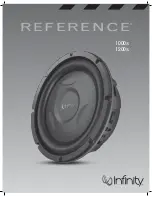
REFERENCE
®
V
ENTED
E
NCLOSURES
A vented enclosure acts like a sealed
enclosure at frequencies above its tuned
(resonance) frequency. At resonance
(which is defined by the vent), the vent
produces the majority of sound – the
subwoofer cone is nearly stationary while
the air inside the vent vibrates. This
provides greater mechanical power
handling at and above resonance, but
reduced mechanical power handling below
resonance. Since the subwoofer cone and
voice coil don’t move much at resonance,
airflow across the voice coil is minimized
and thermal power handling is reduced
slightly at resonance.
Vented enclosures provide better
efficiency in the 40Hz – 60Hz range, at
the expense of sound output in the lowest
octave (below 40Hz). The use of an
infrasonic filter is recommended with
vented enclosures. An optimum vented
enclosure for a Reference Series
subwoofer is larger than an optimum
sealed enclosure.
See accompanying data sheet for specific
enclosure dimension requirements.
V
ENTED-
E
NCLOSURE
P
ERFORMANCE
A
DVANTAGES
• An optimum vented enclosure has
greater efficiency and higher output in
the 40Hz – 60Hz range than an optimum
sealed enclosure.
• An optimum vented enclosure provides a
greater sensation of bass than an
optimum sealed enclosure.
• A 1000s or 1200s subwoofer in an
optimum vented enclosure will require
less amplifier power to achieve a given
acoustic output (down to the
enclosure’s resonance frequency) than
in an optimum sealed enclosure.
B
AND
-P
ASS
E
NCLOSURES
Band-pass enclosures can provide the
most output from any amplifier and
subwoofer combination over a limited
band of frequencies, but that additional
output comes at the expense of sonic
accuracy. Band-pass enclosures combine
a sealed or vented enclosure that houses
the subwoofer along with a vented
chamber into which the subwoofer
outputs its sound. The vented chamber
acts as an acoustic low-pass filter which
attenuates high frequencies in the
subwoofer’s output. That attenuation of
high frequencies can make it very
difficult to hear amplifier and speaker
distortion; consequently, you may not be
able to determine when the subwoofer is
in danger of being damaged.
See accompanying data sheet for specific
enclosure dimension requirements.
B
AND-
P
ASS-
E
NCLOSURE
P
ERFORMANCE
A
DVANTAGES
• An optimum band-pass enclosure
provides higher output over a limited
bandwidth than an optimum enclosure of
any other type.
B
AND-
P
ASS-
E
NCLOSURE
P
ERFORMANCE
T
RADE-OFFS
• Band-pass enclosures achieve high
output at the expense of sonic
accuracy.
• An optimum band-pass enclosure has a
more limited bandwidth than an
optimum enclosure of any other type.
• The enclosure’s low-pass filter
characteristics can make it difficult to
hear if the subwoofer is in danger of
being damaged.
• An optimum band-pass enclosure is
usually larger than an optimum vented
enclosure.
B
AND-
P
ASS-
E
NCLOSURE
C
ONSTRUCTION
Band-pass-enclosure construction is more
difficult than vented-box construction
and, as with vented enclosures, the
design parameters for the vented section
must be followed carefully. (The sealed
section is more forgiving of small design
and construction variations.) Fortunately,
there are many prefabricated band-pass
enclosures that are designed to extract
the most output possible from nearly any
subwoofer. Prefabricated band-pass
enclosures are strongly recommended if
you must have a band-pass enclosure. If
you choose to build your own band-pass
enclosure, use medium-density fiberboard
(MDF), glue and screws to construct the
enclosure,and be sure to seal all joints
with silicone caulk.
T
HE
I
NFINITY
R
ECOMMENDATION
Band-pass enclosures are recommended
only for enthusiasts who want high
sound-pressure levels (SPL) without
regard for sonic accuracy. If high SPL
AND great-sounding bass are your goals,
choosing a vented enclosure is
recommended instead.
V
ENTED-
E
NCLOSURE PERFORMANCE
TRADE-OFFS
• Reduced output in the lowest octave
(below 40Hz).
• Reduced mechanical power handling
below the enclosure’s resonance
frequency. The use of an electronic
infrasonic filter is strongly recommend-
ed, to reduce the chance of overdriving
the subwoofer below the enclosure’s
resonance frequency.
• An optimum vented enclosure will
always be larger than an optimum
sealed enclosure.
V
ENTED-
E
NCLOSURE
C
ONSTRUCTION
Vented-enclosure construction is more
difficult than the construction of a sealed
enclosure. The enclosure volume and port
dimensions have a specific relationship
with the physical and electromechanical
characteristics of the subwoofer,
requiring that the recommended
enclosure volume and port characteris-
tics be strictly observed. As with sealed
enclosures, use medium-density
fiberboard (MDF), glue and screws to
construct the enclosure, and seal all
joints with silicone caulk.
T
HE
I
NFINITY
R
ECOMMENDATION
1000s and 1200s subwoofers in vented
enclosures are recommended for
enthusiasts who prefer accentuated bass
response, for those who have plenty of
cargo space to devote to a subwoofer
enclosure and for those who will use a
less powerful amplifier to drive their
subwoofer. The volume and port
dimensions indicated on the included
technical data sheet must be followed
precisely to ensure optimum
performance.
EN




































